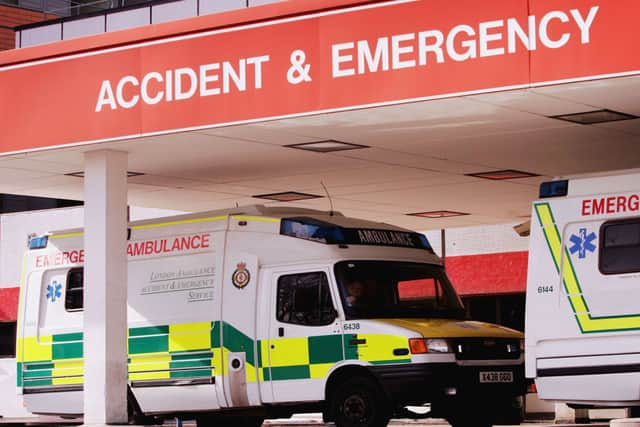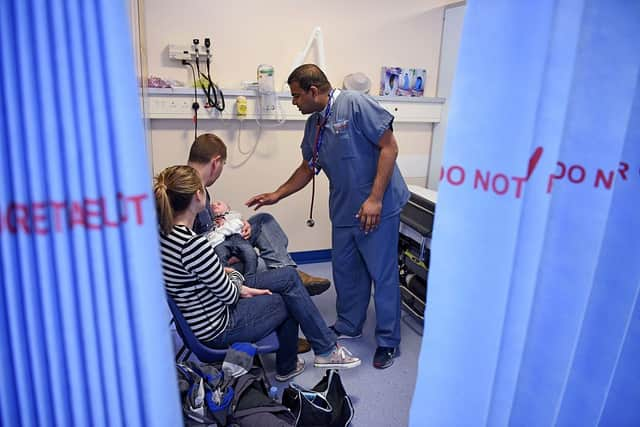NHS: 400,000 patients wait more than a day in A&E, new figures reveal
and live on Freeview channel 276
Medics have warned that 24 Hours in A&E is “no longer just a documentary” after figures revealed that almost 400,000 patients spent a day or more in an NHS England emergency department last year.
The Royal College of Emergency Medicine (RCEM) shared the worrying figures with PA Media, slamming the lengthy waits as “a matter of national shame”. And Dr Adrian Boyle, president of the college, warned that patients are coming to “avoidable” harm as a result.
Advertisement
Hide AdAdvertisement
Hide AdHe told the news agency: “We know that long stays in emergency departments are harmful. There is good scientific data that shows that once people [who need to admitted into hospital] spend more than about six hours waiting, their mortality actually starts to get worse.”
He added that we “must not normalise this very abnormal situation”, remarking: “24 hours in A&E is not just a documentary. It’s a way of life for lots of people, and it’s a way of life for far too many people.”
Dr Boyle said that from start to finish, the entire process of receiving emergency care should take no more than six hours. This, he said, includes a patient being collected by an ambulance, taken to A&E, handed over to emergency department staff, tests being conducted, and then the final decision of either discharging or admitting them to hospital.


“That is not what is happening at the moment,” he said. “The figures we’ve got from the Freedom of Information (FOI) request show us that nearly 400,000 people in England waited over 24 hours in an emergency department. This is because we just don’t have enough beds in hospitals.”
Advertisement
Hide AdAdvertisement
Hide AdHe added that the level of care the NHS is able to offer people “actually feels a little embarrassing at times”, and warned that those who get most impacted by long waits are often “the vulnerable” and “the elderly”.
According to Dr Boyle, the problem is “fixable”, but without intervention from the government, England could see a similar situation in 2023/2024. “We have seen 12 hour stays continue this year with little change, so it is perfectly possible that the 24 hour stays will also continue,” he said.
However, if political parties commit to making some of the changes the RCEM has listed out in its general election manifesto, things could start to look upwards. These include:
- End overcrowding in emergency departments by ensuring there are enough hospital beds
- Provide more funding for social care so that people who no longer need hospital care can be discharged when ready
- Recruit more emergency medicine staff to deliver “safe and sustainable care”
- Improve retention of current staff
- “Resource the NHS to ensure the emergency system can provide equitable care to all”
- Publish more data on hospital performance
Data shows that a record number of 25.3 million people attended A&Es in England in 2022/23 - up 4% from 2021/2022. The statistics also show however that 71% of people spent four hours or less in A&E in 2022/2023, which is not as far as some expected from the NHS Recovery Plan’s target of 76% of patients being admitted, transferred or discharged within four hours by March 2024.
Advertisement
Hide AdAdvertisement
Hide AdAn NHS England spokesperson said: “This data relates to last year and winter, when services were facing record demand, industrial action, and a twindemic of Covid and flu. But since we published our urgent and emergency care recovery plan in January we have seen significant improvements.”
They said that Category 2 ambulance response times are faster than in December, and A&E four-hour performance is up from 69% to 73%. The proportion of patients waiting 12 hours in an emergency department is also down by around 16%.
“We know there is more to do,” the spokesperson continued, “which is why we set out our winter plans earlier than ever before this year - expanding care ‘traffic control’ centres, delivering additional ambulance hours and extra beds to boost capacity and reduce long waits for patients, and other initiatives like same day emergency care units and virtual wards.”
This means patients are “able to get the care they need without an unnecessary trip to an emergency department”, they said, which is both “better for them” and allows A&E staff to “prioritise those with the most urgent clinical need.”
Advertisement
Hide AdAdvertisement
Hide Ad

The health service in England routinely publishes data on different A&E outcomes, including how many people are seen within four hours and how many people wait for more than 12 hours in emergency health departments.
However, figures are not routinely published on 24 hour waits, which prompted the RCEM to submit an FOI to NHS England. The data published from April 2022 onwards is counted as ‘provisional’.
Commenting on the figures, Wes Streeting, Labour’s shadow health secretary, said: “24 hours in A&E was a TV programme, now it’s the reality for hundreds of thousands of patients. Delays reaching patients in an emergency is costing lives.
“The longer we give the Conservatives, the longer patients will wait. Labour will get patients seen on time in an emergency, just as the last Labour Party government did. We will train thousands more staff, reform the health service and fix the social care workforce crisis.”
Advertisement
Hide AdAdvertisement
Hide AdMeanwhile, a Department of Health and Social Care spokesperson said: “No patients should be waiting longer than necessary.
“That’s we have set out the widely-endorsed urgent and emergency care recovery plan since this study was carried out, which aims to deliver one of the fastest and longest sustained improvements in waiting times in the NHS’s history, including creating 5,000 permanent staffed hospital beds, with recent improvements made in A&E performance compared to last year.”
Comment Guidelines
National World encourages reader discussion on our stories. User feedback, insights and back-and-forth exchanges add a rich layer of context to reporting. Please review our Community Guidelines before commenting.
